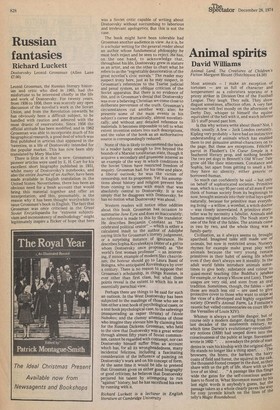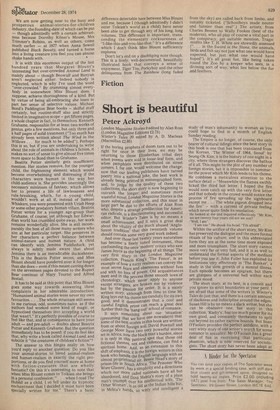Animal spirits
David Williams
Animal Land. The Creatures of Children's Fiction Margaret Blount (Hutchinson E4.50)
Most animals — I make an exception of tortoises — are as full of character and temperament as a coloratura soprano or a pricey striker in Division One of the Football League. They laugh. They sulk. They show disgust sometimes, affection often. A very fast racehorse will feel moody on the afternoon of Derby Day, whisper to himself the equine equivalent of the hell with it, and watch inferior 33/1 stuff pound past him.
Is this why writers write about them? Not, I think, usually. A few — Jack London certainly, Kipling very probably — have had an instinctive understanding of animals which has enabled them to put genuuine animal-characters on to the page. But these are exceptions. Felicite's parrot in Flaubert's Un Coeur Simple is a feathered literary prop, and nothing besides. The two pet dogs in Bennett's Old Wives' Tale grow old like their mistresses, Constance and Sophia, but apart from getting to smell a bit, they have no identity, either generic or borrowed-human.
So much can confidently be said — but only on behalf of sophisticated societies. Primitive man, which is to say 95 per cent of all men if you think of human society from its beginnings to now, brought animals into their tribal lays quite naturally, because for primitive man everything living — a willow, a wombat, a witch-doctor — was closely interrelated. A primitive storyteller was by necessity a fabulist. Animals and humans mingled naturally. The Noah story is one of the first of the fables. The animals came in two by two, and the whole thing was a family-party.
Civilisation, as it always seems to, brought. apartheid. Imagined tales still made use of animals, but now in restricted areas. Nursery rhymes for example make great play with animals because the very young remain primitives in their habit of seeing life whole even if they don't always see it steadily. In the adult world fables introduce animals sometimes to give body, substance and colour to • quasi-moral teaching (the Buddha's jatakas for example, or Aesop's Mouse and Lion). These usages are very old, and stem from an oral tradition. Sometimes, though, the fables — and these are much less old — are used to give protective cover to those who want to snipe at the vices of a developed and highly organised society (Orwell's Animal Farm, La Fontaine's caustic but veiled commentaries on court life in the Versailles of Louis XIV).
Whimsy is always a terrible danger, but of course only a modern danger, dating from the last decades of the nineteenth century, by which time Darwin's evolutionary-revolutionary notions (1859) had seeped down into the consciousness of the public at large. Stevenson wrote in 1892:". . nowadays the pride of man denies in vain his kinship with the original dust. He stands no longer like a thing apart.. . The browsers, the biters, the barkers, the hairY coats of field and forest, the squirrel in the oak, the thousand-footed creeper in the dust, as they share with us the gift of life, share with us the love of an ideal.. . ." A passage like this flings wide the gates for the self-conscious animarisers to flood in. What Stevenson meant by his last eight words is anybody's guess, but the passage taken as a whole clearly paves the v‘'Y e for cosy juvenile kitsch on the lines of th telly's Magic Roundabout.
We are now getting near to the busy and
prosperous animal-stories-for-children industry, the founding-date of which can be put — though admittedly with a certain arbitrariness because Dorothy Kilner's Mouse, Mrs Trimmer's Robins, as well as others, come much earlier — at 1877 when Anna Sewell published Black Beauty, and turned a horse into a living creature you feel you can almost shake hands with.
It is with this enormous output of the last hundred years that Margaret Blount's interesting but over-crowded Animal Land is mainly about — though Beowulf and Bunyan aren't neglected either. Indeed nobody is neglected, which is why I've used the word "over-crowded." By cramming almost everybody in somewhere Miss Blount does, I suppose, achieve thoroughness of a kind. But by virtue of being all-embracing she loses in part her sense of selective values. Michael Bond's Paddington Bear books — skilful stuff certainly, but routine-stuff also and strictly limited in imaginative scope — get fifteen pages, a whole chapter in fact, to themselves. Kenneth Grahame, responsible for at least two works of genius, gets a few mentions, but only three and a half pages of solid treatment ("Too much has already been written about The Wind in the Willows.. . for much to be added"). Perhaps this is so, but if you are undertaking to write about the role of animals in children's fiction, it makes no sort of sense to give almost five times more space to Bond than to Grahame.
Beatrix Potter similarly gets insufficient mention. Her stories remove, for the younger child, the frightening element which would become overwhelming and distressing if the characters were human in the way her child-audience is. She provides unerringly the necessary minimum of fantasy, which allows her to present a life of lawlessness and rule-breaking, which, for a young child, wouldn't work at all if, instead of Samuel Whiskers, you were presented with Uriah Heep or some other predatory human villain. Beatrix Potter writes for a younger age-group than Grahame, of course; yet although her Edwardian world has crumbled quite away, her work remains wonderfully alive. She is still incomparably the best of all those many writers who aim at her particular target. She preserves in her characters a perfect balance between animal-nature and human nature. A child can identify with Jemima Puddleduck, yet always is subtly made aware that about Jemima there is an ineradicable duckishness. This is the Beatrix Potter secret, and Miss Blount should have pondered over it for longer than she does — even if this meant cutting down on the seventeen pages devoted to the Rupert Bear continuo of Mary Tourtel and Alfred Bestall.
It has to be said at this point that Miss Blount goes some way towards answering these complaints in her admirable introduction. "Humanised animal stories were never my own favourites.. . . The whole structure still seems to me curious, odd, sometimes naive, as if the authors had worked some kind of magic, or hypnotised themselves into acceefing a world that Wasn't." It's perfectly possible of course to feel like that, and in consequence to have your adult — and pre-adult — doubts about Beatrix Potter and Kenneth Grahame. But the question immediately has to be posed: if you do feel like that, why write a book called Animal Land, and subtitle it "the creatures of children's fiction"?
The answer to this hinges really on how You'd reply to another question: Do you like Your animal-stories to blend animal-realism and human-realism in exactly the right proPortions, or do you find yourself more at home With fiction-creatures that are wholly fantastic? On this it's interesting to note that When Miss Blount comes to Tolkien she brings in a personal confession:' . . when I read The hobbit as a child, I so fell under its hypnotic enchantment that I decided it must have been Specially written for me." There's a basic
difference detectable here between Miss Blount and me, because I (though admittedly I didn't enter Tolkien's world as a child) have never been able to get through any of his long, long volumes. This difference is important, transcending the elementary cocksureness of "I-like-this-and-you-like-that." It's a difference which I don't think Miss Blount sufficiently explores.
Don't let's end on a disobliging note though. This is a liVely, well-documented, beautifully illustrated book that conveys a sense or enjoyment. Tiger Tim, Porkyboy and the other delinquents from The Rainbow (long faded
from the sky) are called back from limbo, and suitably ticketed. ("Schoolboys made neuter and funnier than real".) The artists, from Charles Bennet to Wally Fookes (best of the moderns), who all play of course a vital part in the conspiracy, get suitable mention. Tragic misfits like T. H. White are shrewdly assessed
. . in the Sword in the Stone, the animals, birds and fish say not just what one would have expected, but just what one would have hoped"). It's all great fun, like being taken round the Zoo by a keeper who sees, in a divining sort of way, what lies below the fur And feathers.















































 Previous page
Previous page